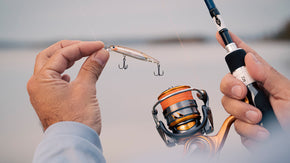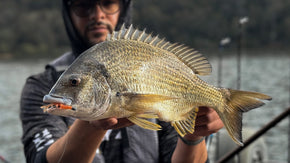Posted 27th June 2025
How to look after your fishing tackle


By Robert Thornton
Right at the heart of fishing is the fishing tackle we use to do it – on the physical level, anyway! Fishing tackle represents the tools of our trade, and without them, our beloved pastime can’t happen.
Care and maintenance are of utmost importance for any kind of tool, but this is something that is commonly overlooked when it comes to fishing tackle. Good quality gear isn’t cheap, and is best understood (or justified) as an investment rather than a purchase.
Aside from saving you money in the long run, looking after your gear with regular care and maintenance has several other benefits. These include reducing the risk of failure and malfunctions, and sometimes even improving their performance over time. Furthermore, various care and maintenance hacks can prevent other mishaps that occur via a follow-on effect, such as line breakages from a rusty line roller on a spin reel, or corrosion on rod guides caused when unwashed hooks are clipped on them.
In this blog we’ll look at why care and maintenance are important, and some ways you can maximise the life of your gear when it’s in use, when it’s not, and some extra tricks to keep your tackle performing like new.

MODERN TACKLE IS A GAMECHANGER
In years gone by, taking care of your fishing tackle wasn’t nearly as straightforward as it is now. Where now a simple spray and wipe is sufficient after care in most cases, anglers use to completely disassemble their reels and clean the individual parts, before painstakingly putting it all back together. Bindings on rod guides would also regularly unravel and would need to be either re-bound or the entire rod replaced.
Things like neoprene reel bags, rod socks and lure-specific tackle trays also didn’t exist to protect gear when traveling. Because of this, anglers had to either create their own systems or endure a high turnover rate.
Working in a tackle shop, I have noticed that the older generation are, on average, better with the technical side of fishing tackle care and maintenance. This isn’t because us young’uns don’t have the brains or appreciation for our gear, but rather because these skills aren’t a necessary part of tackle ownership like they were in previous decades.
These days, complex mechanisms that prevent internal corrosion on reels and improved rod building technology mean their owners seldom need to service or repair them on a regular basis. On top of that, there are professional services available for more involved maintenance and repair work. Even Daiwa offers reel repair and service, which you can check out here.
HOW TO LOOK AFTER YOUR FISHING TACKLE
Effective fishing tackle care and maintenance happens at all stages of ownership, and can be practised when in use, when traveling, after use, and when in storage. Care and maintenance can be extended to everything from rods, reels and lines, to lures, hooks, swivels and other terminals, and even down to your tools and accessories.
Let’s break it all down and look at how to maximise the life of your fishing tackle!
When in use
There are things you can do to look after your gear when out on the water and actually using them, and while some are seemingly small and inconsequential, they can add years to the life of your tackle.
First and foremost is to avoid completely submerging your fishing reel in salt or freshwater. While most modern reels are reasonably water-resistant, complete submersion can see water seeping into the internal parts where it can’t drain properly. If this happens – even for a brief second – the best thing to do is take the reel apart at the end of the session (either yourself or with the help of a professional), clean everything, and allow everything to air dry.
Secondly, avoid putting reels down on sand, dirt, or any other kind of granular substance – wet or dry. Sand and other particles can cause damage to the reel mechanism if they get caught inside, especially if they aren’t cleaned out quickly and spend time rattling around in the gears. Once again, a complete strip-down and clean is a safe remedy if you suspect your reel has sand inside.
Next, make sure you are well aware of your rod’s casting weight limitations. This information can usually be found on the rod blank, and while it’s only a guide, the recommendations on most modern gear are fairly accurate. Plenty of graphite rods get broken when anglers try to cast lures or sinkers beyond the rod’s rating.
When resting your rod against something, whether it’s a rail, tree branch, rock ledge or anything else, take care to position it there as gently as you can. Rods are designed to be rested against things; however sharp impacts can create weaknesses in the rod that only becomes apparent when unexpected breakages happen later on.
Storage and travel

Travelling is when a lot of tackle gets broken, whether in a car, on a bike or out in a boat.
Rods and reels should be protected in vehicles, and secured so they can’t bounce around too much.
One of the best ways to minimise damage to reels when travelling is putting them in a neoprene reel bag, with spin and baitcast options available from Daiwa. These bags even fit over the reel while it’s mounted on the rod, so there’s no need to pack everything down completely on the way to your destination.
Rods are exposed to similar hazards in the car and boat, but there are products to mitigate harm. Rod socks that slide over one-piece blanks are a great way to reduce damage from bumps in the road and on the water. Neoprene rod straps are best for breaking down multi-piece rods and keeping them in a neat bundle, with the soft material providing a cushion affect.
I often keep my rods and reels in their bags and socks when storing them too, but only after they’ve been washed and dried, and I’ll wash the bags and socks as well if they’ve had saltwater on them. It’s a good idea to take your reels off rods when storing, especially if not using them again for a while. Leaving them on for too long can allow saltwater and other gunk to build up around the reel seat, and it’s a good idea to unmount reels for cleaning every so often anyway.
Even if you don’t have bags or socks for your rods, make sure they are stored so they aren’t bending, as this can cause a permanent bend in the rod, which no one wants. Additionally, it’s a good idea to unrig your outfits when storing them, as this will minimise tangles and other dramas when you go to grab them again.
Keeping lures and other terminals in purpose-built trays, boxes and wraps is a good habit to get into for storage, travel and when out on the water. Storage products for terminals and lures like the Bait Junkie Zip Case, Emeraldas Egi Case, Jig Roll, and the D-Box series are ideal for keeping lures and other terminals in. These products ensure terminals don’t become a tangled mess, minimise damage during travel, and make finding them when you need much easier.

After care and maintenance
Saltwater is the biggest threat to fishing tackle, so after a session in the salt it’s really important to do some basic after care.
Rods need to be cleaned thoroughly with freshwater, paying particular attention to the foot of each guide, as this is where rust can build up. After this they can air dry and be put into storage.
With reels the process is a bit more delicate. Tighten up the drag, and then using a mist setting on your hose, give each side of the reel a quick splash without completely soaking it. After that, I like to give the reel a quick spin, which shakes off excess water, before backing the drag right off and allowing it to air dry. Once dry, the reel is bagged up and put into storage.
Lures and terminals also need to be cleaned after saltwater use, and my usual routine is to keep any lures I use during the session in a separate tub. Keeping these lures in their own tub ensures I don’t get saltwater in my storage trays and boxes. After the session I’ll fill this tub with freshwater, before draining and allowing the lures to dry. Once dried, they can go back into their respective storage compartments.
Storage units themselves should also be washed if any saltwater gets inside, but should always be kept as dry as possible. A little trick I learnt is to keep desiccant sachets from packet food products and put a few of them in your tackle boxes, as they suck up moisture and reduce potential corrosion. A few grains of rice in each compartment is a handy budget alternative to this – it works too! Just make sure to change the rice every few weeks.
Daiwa sells reel greasers and oilers for medium and long-term maintenance, however I personally prefer to let a professional do this for me. In all honesty, I rarely need to grease or oil my reels simply because of how well made many modern reels are.
With lines, both braided and monofilament mainlines should be changed every 2-3 years, depending how much use they get. Old lines can lose you fish and tackle, plus they can become prone to wind knots and other inconveniences as they age. As a guide, if you can’t remember when you last changed your line, you probably need to change your line!
A LITTLE GOES A LONG WAY
Routine care and maintenance is the best way to ensure you get optimal performance and maximum longevity out of your fishing tackle. Fishing is a rigorous task for such small pieces of machinery, and while they’re built to handle punishment to a point, there’s things we can do to keep them working for longer – as we’ve discussed.
You don’t need to baby your fishing tackle, but it makes sense to treat them with the same care you give a car, your boat, your trusty rifle, metal detector, or anything else that allows you to do the things you love.
















